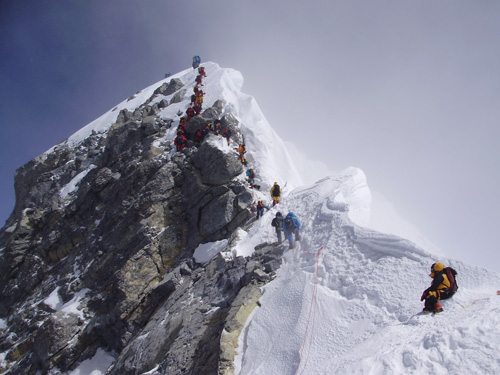|
|
The South
Asian Life & Times - SALT |
|
|||
|
Contents Adventure & Sport Five
Ultimate Everest Apa
Sherpa-21 Times
|
|
||||
|
-
From an Expedition peak to a Commercial peak
Other Names: Chomolungma (Tibetan) or "Goddess Mother of the World";
Sagarmatha (Nepalese)
Height: 29,035 feet, (8,850 meters) Everest is the highest point on Earth.
Location: On the border of Nepal and Tibet
Coordinates: 27°59′17″ N / 86°55′31″ E
Age: About 60 million years old
First Summit: Sir Edmund Hillary and Tenzing Norgay on May 29, 1953
Climbers: In the last 60 years, 15,000 men and women have tried to climb
Everest. Over 3,000 have succeeded and more than 200 have died.
Rising nearly five and a half miles (8.85 km)
into the sky, Mount Everest in the Himalayan range is the tallest mountain,
above sea level, on earth. The first humans to step on the
60-million-year-old were Edmund Hillary and Tenzing Norgay, who made history
sixty years ago in May 1953 – no human being before them had stood on the
summit of the highest mountain in the world and experienced its altitude.
They went up Everest as committed adventurers and came down as 20th
century icons. Hillary, a
tall, lanky, amiable beekeeper from New Zealand, and Tenzing, his
ever-smiling Sherpa guide from Nepal/India, were part of the British
expedition led by John Hunt. And so was James Morris, the ‘Times’
correspondent from London covering the expedition, who managed to get the
news, through an elaborate system of codes and runners, into the paper on
the morning of 2 June 1953 – the news of their success arrived in London on
the morning of the young Queen's coronation - and turned it into a double
celebration. The Queen promptly made Edmund Hillary a Knight Commander of
the Order of the British Empire, while Tenzing Norgay received the George
Medal of Britain and other
honours. Before the
1953 British expedition, 10 major expeditions had attempted - and failed -
to reach the summit. And Tenzing had been on six of them. In 1924, two
Britons, George Mallory and Andrew Irvine, disappeared trying to reach the
top. Though
Sherpas and their Tibetan kin had known Everest - or Chomolungma - for
centuries, not one of them had wanted to climb it until Tenzing Norgay came
along.
|
|||||
|
Copyright © 2000 - 2013 [the-south-asian.com]. Intellectual Property. All rights reserved. |
|||||
